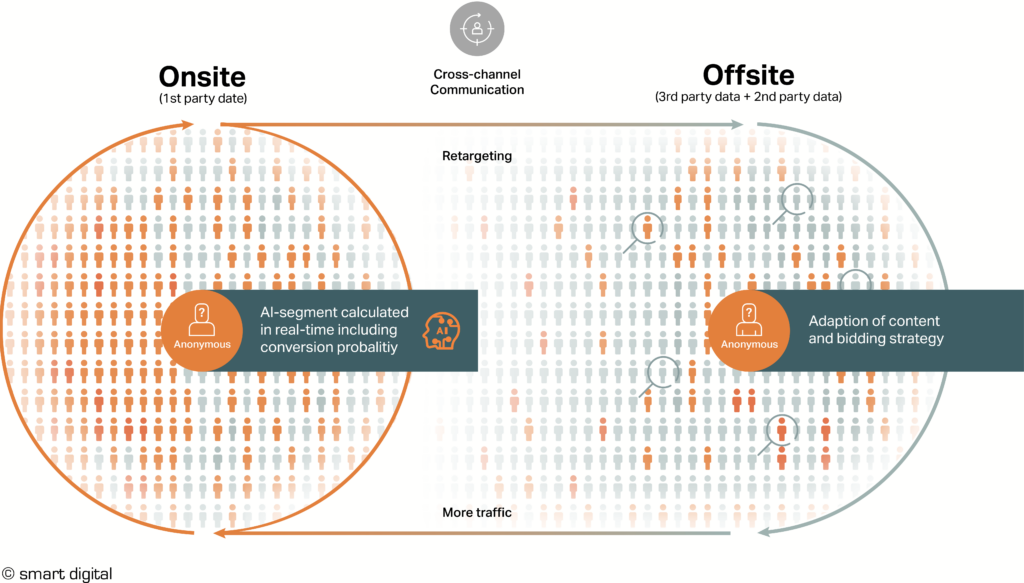Today’s marketing is suffering from a seemingly unsurmountable dichotomy: the separation in an onsite and an offsite communication sphere. Unfortunately, customers are moving in and across both worlds within their customer journey, thereby following highly individualized patterns. But, as owned and paid touchpoints are poorly related to each other, when it comes to sharing relevant information and martech and ad tech infrastructure, there are some unpleasant and costly effects of these silos:
- customers “lost in space” and therefore divergent target group audience reaches,
- disconnect in audience definition between media campaigns (paid channels) and onsite campaigns (owned channels),
- unused potential of incoming data (2nd and 3rd party data)
- and – not to underestimate in its negative outcome on brands – different experiences for users on various touchpoints.
Bottom line – decreasing impact and efficiency of onsite and offsite marketing activities – with negative effects on the propensity to generate a lead or a sale.
So, what to do?
Why it all starts with onsite personalization
Many of us use platforms like Amazon, Facebook or Spotify, where we have become accustomed to getting what we want, even before we know that this is or even what we are looking for. We have been disciplined subconsciously to know when our online experience is personalized to our needs, and clearly when it is not. So, the insights in customers’ needs and demands, companies can generate a highly personalized onsite user experience are the starting point for any successful offsite marketing activity. Concentrating on utilizing user-based data that you own is key for any future marketing activity. Hence, 1st party data should be at the heart of decision-making for user-centered communication.
1st party data should be at the heart of decision making for user-centered communication
What needs to happen offsite?
It´s fair to say that today´s users expect the same experience onsite and offsite. So, AI-built segments based on 1st party data need to be utilized for offsite media campaigns to accurately retarget the user with further relevant content and continuously optimize target audiences and segments. Communicating with the user in a comprehensive and consistent manner on various and ideally on all digital touchpoints is indispensable for an integrated user experience and a high purchasing probability.
The offsite – onsite trap: The missing back link between both data worlds
Once out in the offsite world, the most crucial and at the same time most frustrating moment in the customer journey is the user’s return from any offsite touchpoints to onsite.
At this point, much too often users are sent several steps backward from where they had initially left within their customer journey. This experience usually throws them off their customer journey, as the generic landing page is not intuitive due to the missing data back-link between offsite and onsite. Consequently, offsite data needs to be linked into the onsite user experience as well to provide a even better onsite experience. A user will click on the banner ad and will be led to the personalized landing page with that exact product or service with the right recommended size, color, etc. and the propensity to buy will grow. In other words, the onsite and offsite worlds have to be intertwined by data in both directions.
 Graphic 1. Cross-channel communication to synchronize the user experience
Graphic 1. Cross-channel communication to synchronize the user experience
The Onsite and offsite worlds have to be intertwined by data in both directions to create user-centric communication.
We like to think of this as a Data Pretzel, intertwining both, offsite and onsite data, to become a single data platform, for efficient audience targeting across digital touchpoints regardless of where the user is in the journey.
Finally: How does a closed data loop translate into tangible results?
At Smart Digital, we are managing use cases with these connected data-worlds, and the results are remarkable. Using machine learning algorithms to identify the true intent and affinity of the users onsite and provide this information to the offsite retargeting campaign creates up to 30% media investment saving by achieving the same results
Consistently personalizing the user experience saves a third of media spend and more than doubles the conversion
Even better, using offsite data to create a seamless and personalized user experience on the brands landing pages leads to a 120% uplift in conversion results and a 100% uplift in click-through-rates for these connected campaigns.
 Graphic 2. The impact of connecting onsite and offsite data
Graphic 2. The impact of connecting onsite and offsite data
In summary
If user-data is connected like shown in our example, it creates a platform and opportunity to implement a personalized and consistent experience for your users. Campaigns can be optimized in both ways – either making your media spends work harder and save money for the same outcome, or – and we like this version better – increasing your results and help you growing your business.
Photo: Omelchenko| Shutterstock

